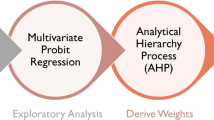Abstract
The Hyogo Framework for Action was conceived to help nations build resilience against disasters. This framework was negotiated and approved by the United Nations at the World Conference on Disaster Reduction, held in Hyogo, Japan, in 2005. Disaster risk reductions systems are multi-agency integrated environment needing clear goals and ways to assess their evolution for planning purposes. The assessment of risk reduction maturity levels in countries/cities is difficult due to the large amount of data that must be collected and integrated to assess what is being done within each action indicated by the Hyogo Framework. Most indicators dependent on human perception are used in this assessment, making it highly dependent on the evaluators’ perceptions. The objective of this work is to propose a participatory fuzzy model able to assess the maturity level of disaster risk reduction using indicators in line with the Hyogo Framework. We apply the model and the evaluation method in an exploratory study in the city of Rio de Janeiro where there are several communities at risk of landslides due heavy rains.





Similar content being viewed by others
References
Dolif G, Engelbrecht A, Jatobá A, Silva AJD, Gomes JO, Borges MRS, Nobre CA, Carvalho PVR (2013) Resilience and brittleness in the ALERTARIO system: a field study about the decision-making of forecasters. Nat Hazards 65(3):1831–1847
Grecco CHS, Vidal M, Cosenza CAN, Santos IJAL, Carvalho PVR (2014) HFA 5 maturity assessment: a fuzzy model for improving safety performance in a radioactive installation. Prog Nucl Energy 70:71–83
Hollnagel E (2008) Safety management e looking back or looking forward. In: Hollnagel E, Nemeth CP, Dekker S (eds) Resilience engineering perspectives, remaining sensitive to the possibility of failure, vol 1. Ashgate, Aldershot, pp 63–78
Hsu H, Chen C (1996) Aggregation of fuzzy opinions under group decision making. Fuzzy Sets Syst 79:279–285
Jovanović B, Filipovi J (2016) ISO 50001 standard-based energy management maturity model—proposal and validation in industry. J Clean Prod 112(4):2744–2755
Lee HM (1996) Group decision making using fuzzy theory for evaluating the rate of aggregative risk in software development. Fuzzy Sets Syst 80:261–271
Olsona D, Wu D (2013) Extreme-event risk management: a review of “Lee, B., Preston, F., 2012. Preparing for high-impact, low-probability events: lessons from Eyjafjallajőkull, London: Chatham House. J Clean Prod 53(15):67–68
Pedrycz W (1994) Why triangular membership functions? Fuzzy Sets Syst 64:21–30
Pullen W (2007) A public sector HPT maturity model. Perform Improv 46(4):9–15
Saaty TL (1980) The analytic hierarchy process: planning, priority setting, resource allocation. McGraw-Hill, New York
Thabrew L, Wiek A, Ries R (2009) Environmental decision making in multi-stakeholder contexts: applicability of life cycle thinking in development planning and implementation. J Clean Prod 17(1):67–76
UNISDR (2007) Hyogo Framework for Action 2005–2015: building the resilience of nations and communities to disasters. UNISDR, Geneva. http://www.preventionweb.net/
UNISDR (2008) Indicators of progress: guidance on measuring the reduction of disaster risks and the implementation of the Hyogo Framework for Action. UNISDR, Geneva. http://www.preventionweb.net/files/2259_IndicatorsofProgressHFA.pdf
Yager R, Filev D (1993) On the issue of defuzzification and selection based on a fuzzy set. Fuzzy Sets Syst 55:255–272
Zadeh L (1965) Fuzzy sets. Inf Control 8:338–353
Zadeh L (1996) Fuzzy logic = computing with words. IEEE Trans Fuzzy Syst 4:103–111
Zimmermann H (1996) Fuzzy set theory and its applications, 3rd edn. Kluwer, New York
Acknowledgments
The authors gratefully acknowledge the support of Conselho Nacional de Pesquisas (CNPq) and Fundação de Amparo a Pesquisa do Rio de Janeiro (FAPERJ).
Author information
Authors and Affiliations
Corresponding author
Rights and permissions
About this article
Cite this article
de Carvalho, P.V.R., dos Santos Grecco, C.H., de Souza, A.M. et al. A fuzzy model to assess disaster risk reduction maturity level based on the Hyogo Framework for Action. Nat Hazards 83, 309–326 (2016). https://doi.org/10.1007/s11069-016-2316-y
Received:
Accepted:
Published:
Issue Date:
DOI: https://doi.org/10.1007/s11069-016-2316-y




